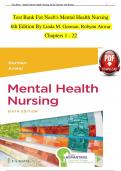Exam (elaborations)
TEST BANK For Davis Advantage for Neeb's Mental Health Nursing, 6th Edition By Linda M. Gorman, Robynn Anwar, Verified Chapters 1 - 22, Complete Newest Version
Davis Advantage for Neeb's Mental Health Nursing (6e by Gorman and Anwar) Davis Advantage for Neeb's Mental Health Nursing, 6th Edition By Linda M. Gorman, Robynn Anwar Davis Advantage for Neeb's Mental Health Nursing, 6th Edition By TEST BANK Chapters 1 - 22 pdf questions answers ebook Da...
[Show more]












